Marsh Samphire / Summer / Edible
Marsh samphire is a really exciting coastal plant growing around estuary marshlands, it has a brilliant salty pop.
Common Names
Samphire, Sea beans, salt fingers, glasswort
Botanical Name
Salicornia europaea
Scientific Classification
Kingdom – Plantae
Order –Caryophyllales
Family – Amaranthaceae
Physical Characteristics of Marsh Samphire
Samphire is an annual growing from 3-30cm tall.
A Marsh Samphire Foraging Video
Leaves and stems
It’s a succulent and fleshy plant, with opposite scale-like leaves and heavily jointed stems.
Flowers
The flowers are tiny and sunken into the joints of the stems, they’re actually quite difficult to see as are the small succulent fruits containing one single seed.
Habitat
Marsh Samphire grows all around the coast of Britain but East Anglia is where it is best known and most widely used. The distribution and abundance of Marsh Samphire is constantly changing. It is amongst the earliest colonisers of fresh, bare estuarine mud where you can find samphire “lawns” in the first few years of its establishment but these decline as the mud stabilises and perennial saltmarsh species move in.
The best Samphire is washed by every tide, ie, below the high tide level of the marsh, at the very seaward edge of the marsh on the fresh mud or in the deep creaks which riddle the marsh.
Known hazards
The main hazards are in harvesting rather than eating Samphire.
The areas in which samphire is found are muddy areas where it is easy to get stuck in the mud. It is best to wear footwear with a large surface area of sole to distribute your weight evenly and reduce the depth you sink into sometimes very deep mud
Reaching the creeks where samphire is likely to be found involves traversing areas of saltmarsh often covered with sea purslane which grows over and hides the narrower creeks which riddle the marshes. It is therefore important to keep your eyes on the ground to identify these creaks as otherwise you can take a sudden drop and risk injury.
As the best specimens are found below the high tide mark it is important to be aware of the tidal cycles and be sure to start harvesting as the tide goes out to allow plenty of time before the tide comes back in, or you could end up swimming back!
Could be confused with
Other glasswort plants. Potential to pick Sea Spray (Suaeda maritima) whilst picking samphire, not to worry – it’s edible too.
Sometimes people mistake the Samphire we’re talking about here with something called Rock samphire (Crithmum maritimum)– they look completely different but have very similar names. The flavour of the two is also completely different, rock samphire is more like punchy carrot tops flavour compared to the regular samphire which has mineral rich and salty flavour. You wouldn’t want to get the two swapped in a dish as you’d be tasting something quite different.
One of the other key differences is that samphire grows on the mud flats of most estuaries whereas the rock samphire grows on rocky edges and cliffs.
Edible Use
Stem: Salads, steamed, boiled, fried, raw, stews, pickled, candied, frozen, caramelised, pesto.
If you’ve picked older specimens or pulled them with the root then you’ll have a woody section in the lower sections of the plant, you can cut this away and use just the tips which have a nice crunch but won’t be horrible and stringy.
The best time to forage for Marsh Samphire is late spring – late May to summer, though it is said that picking shouldn’t really begin until after the summer solstice.
In the past samphire was gathered when it was six to nine inches high by being pulled up by its roots. This is now illegal under the Wildlife and Countryside Act and it is best and less time consuming in the long run to pinch or use scissors to snip the stems above the tough, yellow lower stalks.
As the plant grows taller the woody stem becomes longer so it is important to cut above the woody stem. Later in the season the samphire appears very tall, but the succulent edible section at the top of the stem becomes shorter.
Notes on Herbal uses
This plant holds a vast abundance of micro and macro minerals.
Samphire is thought to have digestive, diuretic and detoxification properties. It is rich in antioxidants which could explain why it may have anti cancer effects on the gastrointestinal tract.
This salty vegetable is loaded with a variety of nutrients. Samphire is rich in vitamins A, C, B2, and D as well as having high levels of Iodine, iron, calcium, magnesium, silica, zinc and manganese. Additionally, samphire is rich in fibre and amino acids. The iodine content in samphire is particularly helpful for individuals with an under-active thyroid.
Subspecies
Twenty or thirty subspecies of annual samphire have been identified, each with a distinct ecological niche – some prefer the fresh, bare mud and others can be found higher up in the saltmarsh, near the high tide mark. I’ve tried to identify different species in different parts of the marshes that I live near but have only really found three that have noticeable differences and they all taste pretty much the same. It may be that the other subspecies are found in different parts of the UK. There is one subspecies called Norfolk Samphire, Salicornia Europaea, one which looks like a Christmas tree, Salicornia ramossisima and one which the locals call Sheep Sanfer, found mainly around the high tide mark at staithes and harbours.
Saicornia europaea
Norfolk Samphire, Saicornia europaea, is an erect pale green to yellow with many hardly beaded, short opposite, cylindrical branches.

I, Thesupermat, CC BY-SA 3.0, via Wikimedia Commons
It is a plant of the muddiest zone of the salt marsh, amongst the earliest colonisers of fresh, bare estuarine mud where you can find samphire “lawns”.

As a pioneer species it helps trap mud to facilitate the establishment of later species in a succession.
Salicornia ramossisima
Salicornia ramossisima is a dark shining green annual with each segment convex; contractions between the segments give the stem a beaded effect. This is found in the middle more consolidated parts of the salt marsh often on the sides and tops of deep creaks. The plants are often described as Christmas tree shaped. When it comes into flower it looks like a Christmas tree with fairy lights – I think salt crystals must get caught around the tiny flowers and they catch the sun.
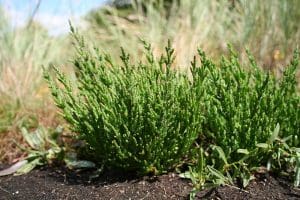
Salicornia perennis
Salicornia perennis (Sheep Samphire) is a perennial with creeping woody stems up to a metre long that produces low bushy tussocks of ascending green to orange yellow shoots up to 20cm tall. This is found on firmer, often gravelly parts of the salt marshes, often around staithes or harbours.
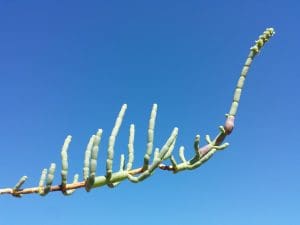
This is the only Samphire I don’t bother picking. Locals near me call it Sheep Samphire. It grows closer to the high tide mark on more gravelly ground and sends a running root across the surface from which the succulent green sprouts arise. The green sprouts don’t get very tall though so gathering it is hard work.
Ecological value of Marsh Samphire
Salicornia species are used as food plants by the larvae of some Lepidoptera species, including the Coleophora case-bearers C. atriplicis and C. salicorniae (the latter feeds exclusively on Salicornia species.).
Samphire has a role in the early stages of salt-marsh succession, as the primary colonist on muddy substrates. Part of its role within the succession is to stabilise the mud to prevent it washing away and introduce organic matter which encourages establishment of other plants. This is another reason it is important to cut the stems rather than pulling it up by the roots.
In coastal locations, Twite, Carduelis flavirostris eat the seeds of samphire.
Extra notes from the Foragers
The ash gathered from burning this plant was historically used in the production of soap and glass (it is a strong alkali known as potash)
It has been reported that it is illegal to pick samphire – this is true in that it is illegal to uproot a plant under the Wildlife and Countryside act but authorities are not overly worried as there is so much of it and it is an annual species which produces a lot of seed. Even so, I don’t uproot the plants but cut them above the woody stem. This allows the plant to continue living and contributing to the reduction of CO2 in the atmosphere by photosynthesysing.
Concerns have been raised in the past after TV chefs have used samphire in a recipe, encouraging people to overun the fragile marsh environment. There are also large gangs of foragers that go out and trash the marshes while collecting Samphire in some areas but it is difficult to police the marshes and catch the culprits. Occasional picking is acceptable in moderation.
Samphire was once used to make glass and soap, hence the alternative name, Glasswort. Samphire species have a high concentration of sodium salt. In the past, the plants were dried and then burnt in large heaps and the ash was heated with sand until it fused into a crude glass, or leached with limewater to make a solution of caustic soda. This was evaporated and the resulting sodium hydroxide crystals were used to make better quality glass or heated with animal fats to make soap.



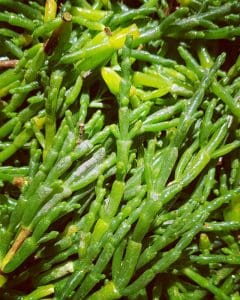
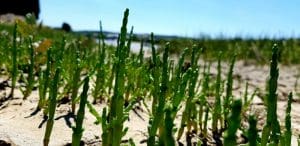
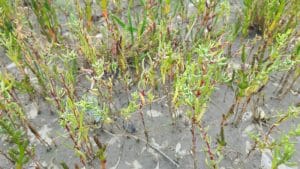
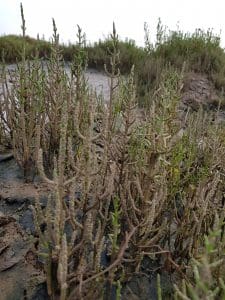
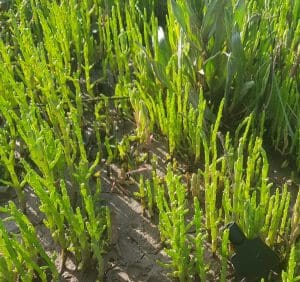
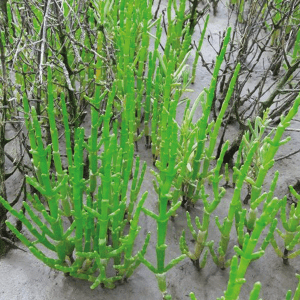
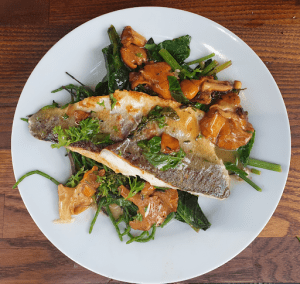



1 reply on “Marsh Samphire (Salicornia europaea) Identification Guide”